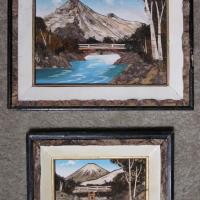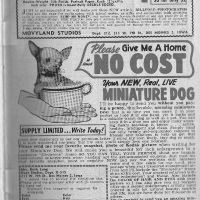We decided to share something a little different this week, and if our readers find this useful, we may do some more tutorials down the road. First off, we have to make a confession about the amount of paper “this and thats” that find their way into our respective homes. We both love old cards, postcards, Valentines, prints, Victorian “scraps” ads, cards—you name it and we probably have some. But, one of our favorite things is old scrapbooks. You never know what cool things you are going to find in them. So, OK, we are going to assume that you have this same problem. You found a terrific print in one of those scrapbooks, and you want to make a card, frame it, or otherwise use it free from the surrounding book. In this tutorial I will show you how to remove your prize safely, so it can be used again.
Before we start, though, I want to give a great big HUGE warning. Do not attempt this on anything that is “priceless”. If it means the world to you, take it to an expert. Also, this is not recommended for photographs, and you might want to think twice about letters. If you have some question about the printing being able to stand up to water, do a test in one corner to be sure. Most old prints are very stable and able to take this. Removing a good rag paper print from an old acidic book will keep the print from further yellowing. This method will only work with the old water-soluble glues. Most scrapbooks from the ’60s and earlier will be no problem.
So here is our scrapbook:
 This one is actually an old teacher planning book that someone pasted stuff into. Mostly cute magazine pix, like the one shown. We are going to destroy the book while removing the pix, but there is not much here to save. If you want to save the book, you will have to remove the pictures using a cloth soaked in water, and that is a lot more complicated. Let’s start the easy way.
This one is actually an old teacher planning book that someone pasted stuff into. Mostly cute magazine pix, like the one shown. We are going to destroy the book while removing the pix, but there is not much here to save. If you want to save the book, you will have to remove the pictures using a cloth soaked in water, and that is a lot more complicated. Let’s start the easy way.
First off, gather your materials:
- A plastic bin large enough for your page. You can use a pan, just something to hold water, but not that story you told your hubby about where all the paper stuff keeps coming from. That story leaks like a sieve!
- Paper towels
- An old cloth towel or rag
- Two sheets of glass or plexiglass
- Your scrap book
- And a supply of patience. Not a lot, but it does take some.
Here is the page I choose out of the book:
 This one will net me two cute prints. Sometimes, if there is stuff on the back, you can get a whole lot off at once. For us, right now, just a twofer.
This one will net me two cute prints. Sometimes, if there is stuff on the back, you can get a whole lot off at once. For us, right now, just a twofer.
Fill your bin with an inch or two of water:
 Don’t overfill it; you need a bit of room to work, as well as minimizing the mess when you trip on your way to the sink to dump it. (Don’t ask!)
Don’t overfill it; you need a bit of room to work, as well as minimizing the mess when you trip on your way to the sink to dump it. (Don’t ask!)
Now take your page and gently submerge it:
 Make sure the water covers all of the picture. If there is paper from the book itself hanging out of the water, that is fine, just make sure the whole picture is down and stays down. It might take a minute of gently pushing it back in, till it wants to stay.
Make sure the water covers all of the picture. If there is paper from the book itself hanging out of the water, that is fine, just make sure the whole picture is down and stays down. It might take a minute of gently pushing it back in, till it wants to stay.
Here is where the patience comes in. Walk Away. Go make yourself a cup of coffee, call your talkative aunt, whatever it takes to leave it alone for a half an hour or so. It can take more or less time, and you will figure out how much, if you are doing several things from the same book. Depends on the scrapper’s predilection for glue, and the type used; just don’t rush it.
Come back and take a look:
 If you are lucky, you will notice that the paper has floated free. Otherwise, gently try a corner. If it still seems sort of stuck, then go find another relative to chat with. You can peel things up, but the paper has much less strength when wet. You run the risk of tearing your picture, so just take it easy.
If you are lucky, you will notice that the paper has floated free. Otherwise, gently try a corner. If it still seems sort of stuck, then go find another relative to chat with. You can peel things up, but the paper has much less strength when wet. You run the risk of tearing your picture, so just take it easy.
Once you have your item freed from the backing, turn it over and delicately rub off any excess glue:
 You can tell if there is still some on the back by the slight slimy feeling. Just rub very gently with your fingers till that is gone. (If this only worked with used car salesmen!) This is why you need room to work in your tub.
You can tell if there is still some on the back by the slight slimy feeling. Just rub very gently with your fingers till that is gone. (If this only worked with used car salesmen!) This is why you need room to work in your tub.
Now, lift the item from the water and lay it out on your cloth towel. If the item seems likely to tear, you can slip one of your pieces of glass into the tub and slide your picture onto it like this:
 Once the items are removed from the tub, blot as much water as you can with the towel. Make sure the pictures remain on a flat firm surface to avoid distorting or tearing the paper. For more fragile items blot right on the glass. Remove and discard the scrapbook page. (Don’t forget to do the items on the back if there are some!) You can reuse your water, as long as it doesn’t look too gluey; just replace as needed, if you are doing a lot.
Once the items are removed from the tub, blot as much water as you can with the towel. Make sure the pictures remain on a flat firm surface to avoid distorting or tearing the paper. For more fragile items blot right on the glass. Remove and discard the scrapbook page. (Don’t forget to do the items on the back if there are some!) You can reuse your water, as long as it doesn’t look too gluey; just replace as needed, if you are doing a lot.
Once you have blotted the paper and gotten the worst of the moisture off, it is time to lay it out to dry. The paper will curl and wrinkle if you just leave it on the table, so the idea is to keep it as flat as possible while drying. Failing a local elephant to sit on it, we will just make a press by laying out one sheet of glass, a piece of paper towel, and your print:
 Then add another piece of paper towel and the last sheet of glass:
Then add another piece of paper towel and the last sheet of glass:
 This method takes a while, as not a lot of air gets through there, so the towels need to be changed a couple times a day for a few days depending on your humidity. I just leave the paper towels out to dry and just keep switching them back in, so as not to use a whole roll of towels and mess up my carbon footprint. You can also use cloth; just don’t make it too thick, or you will have wrinkles.
This method takes a while, as not a lot of air gets through there, so the towels need to be changed a couple times a day for a few days depending on your humidity. I just leave the paper towels out to dry and just keep switching them back in, so as not to use a whole roll of towels and mess up my carbon footprint. You can also use cloth; just don’t make it too thick, or you will have wrinkles.
As an alternate quickie method on a hot day, you can lay your items out on a screen or your oh-so-handy mesh patio table, then just lay one piece of glass on top of them:
 On a 90 degree day they dry in no time flat, so this works really well when you have a lot to do.
On a 90 degree day they dry in no time flat, so this works really well when you have a lot to do.
And here are your two freed pictures ready to go on and be useful again:
 If you were impatient and got them out before they completely dried, and they wrinkled or curled just a little, they can be lightly pressed with a warm iron. Just don’t get it too hot, or you can turn a whole page yellow!
If you were impatient and got them out before they completely dried, and they wrinkled or curled just a little, they can be lightly pressed with a warm iron. Just don’t get it too hot, or you can turn a whole page yellow!
Hope you enjoyed this, and found it useful. If so, pass it along to someone who might also find it useful, pin it, or bookmark it for future reference. Let us know how it works for you, and if you have any questions, let us know in the comments or feel free to email us.














Very cool! Now what will you do with the illustrations? Love this sort of crafty tutorial – thank you!
Well, some we frame, some are used for homemade greeting cards, and most are hoarded! We tell ourselves that we are saving paper ephemera by getting it off of the old acid paper it’s glued to. Old paper stuff is a good thing to keep around–it’s not very big and can be stored fairly easily. I keep a lot of smaller pieces in acid-free sleeves in a note book.
I have 2 books full of postcards that are glued onto the pages both sides. The books are from a trip to Europe in 1912 & I believe these have been glued down for 100plus years. Should I still soak them off?
Help!?
That’s a tricky one. Are there two postcards that you would be willing to sacrifice if things go wrong? If so, cut them out of the book and try the soaking method. This will give you information on the type of glue used and the stability of the postcards. A few cautions–you might lose anything written on the back of the postcards because old ink is pretty water soluble; if the postcards are photographs or watercolors, this will probably ruin them; PRINTS are the most tolerant of water and usually don’t show any damage if you follow the paper towel and g;ass weight steps. To tell is something is a print, get a loupe/good magnifying glass and look at the postcards. You can see if there are dots, or if the color looks applied. If you can’t tell, then you need to be ready to ruin whatever you try to remove. Lastly, if things go wrong, you could pick your favorites and have a professional remove them. Good Luck and let us know how it went!
https://secondhandroses.wordpress.com/2010/09/26/heres-how-you-do-it/ This is another link that shows how to get a print out of a book with a wet rag. It’s useful when you don’t want to cut a book up. You will probably get the postcard on the opposite wet too, but it might not ruin it.
Hi very interested to see your page. I have old album started in 1900 and it has christmas cards and postcards up to about 1930ish. Should I expect to lose all writing and stamps. I got one off years ago and glue seems to be in glob in centre although stuck all around edges on lots. I managed to identify person who send and captured addressee. I am wondering if I can expect to lose all ink by soaking or if I might be lucky. Any further advice welcome.
The ink can be hit or miss, I would try one that you don’t care about first. The stamps will come off with soaking. It is a standard method to remove old stamps. If the glue is in a glob, you can try dampening just that spot with a wet cloth or paper towel, which may localize the water area. Just lay a wet cloth over the area and let sit for a while. Good luck, and again, if this is very dear to you, have it professionally done.
TY for listening and giving me advice…I have the above scenario…the scrapbook was started in the 1880s. I’ve soaked the page for hours, in vinegar, (which will usually remove anything without affecting the colors) and cannot get the glue to release entirely. I’m working with distilled vinegar…am wondering if you have tried natural vinegar with “mother’. I’ve ruined several pages trying stronger and weaker vinegar mixtures…any suggestions? Do you know of chemicals which will dissolve the old flour based vinegar…do you have a clue as to the type of flour or liquid used used in this type of scrapbooking? Have even resorted to razor blade scraping but to no great
satisfaction as item needs to be wet and tears easily.
I have never tried the vinegar. Usually water does the trick with the old hide glue, and I would think it would work with flour as well, but obviously not. Is there a way to cut around the images and just leave the page? I might go that route as a last resort. Some of these projects just don’t go as planned :(. Good luck and let us know what you end up finding out!
Hi! Have you had any success with old paper tickets like for a movie theater (they gave you the paper ticket at the booth, and then tore it in half inside)? The ones I’m trying to move are from 1935 – 1945. I have many that were never used, and I want to remove them from the old acid-based paper before the acid seems into the tickets.
I have not done this specifically, but I would think the same technique would work. Again, if they are very precious, take them to a conservator, but if you are willing to give it a try, pick the one in the worst condition and give it a whirl. AT that age, there is a good chance the glue will dissolve. I have never had issues with the ink running, but test to make sure. You can always lightly dab with a bit of water and see if anything comes off.